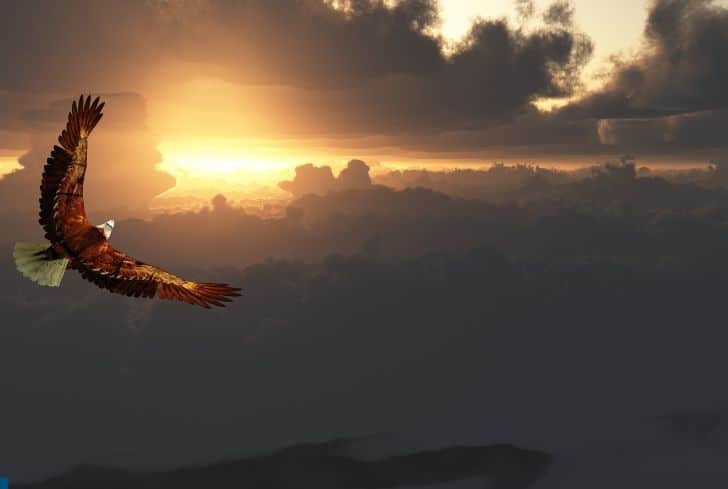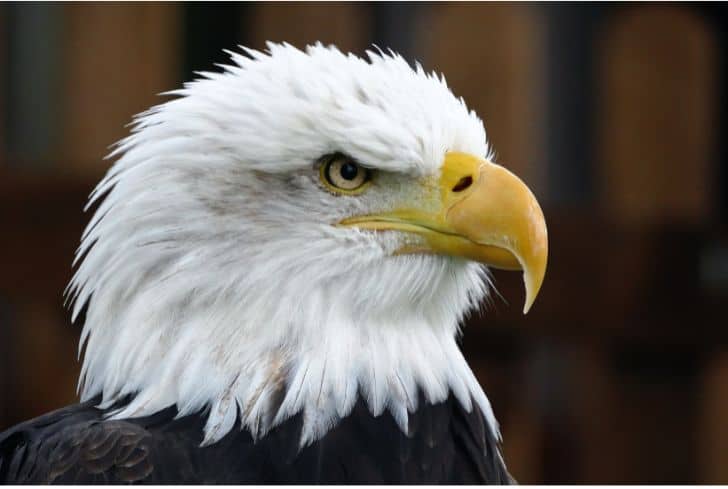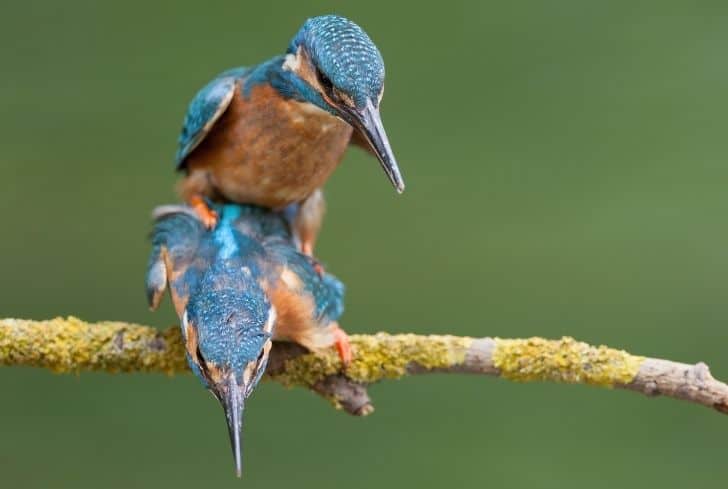Do Eagles Fly Above Storms? (And Fly at Night?)

Have you seen an eagle soaring high in the sky? This magnificent bird is meant to fly high. Unfortunately, mountaineers and hikers breathe with difficulty at higher altitudes, with only one-third of available oxygen, but not the eagle. This is because they have large lungs, a dense network of blood vessels in their wing muscles, specially developed mitochondria in their cell structures and specially modified hemoglobin in their blood.
Eagle is the only bird that embraces the turbulence to push itself higher. When other birds flee from the weather, the eagle actively engages stronger winds to fly high above storms instead of seeking shelter. This article presents astonishing facts about bold eagles. Keep on reading.
Does an Eagle Fly Above the Storm?
Eagles of large size can fly above many storm clouds like golden and bald eagles. They fly up to 11,000 feet above sea level, the altitude at which many small planes fly. As a result, the Eagle enters space when a storm occurs, and it usually cannot reach there in good weather.
This act of boldness gives the eagle a broader view of its surroundings. When the eagle is above the storm, without any rough winds, its flights become smooth with less effort.
How Can Eagles Fly Above Storms?
Many theories have been about how eagles effortlessly soar through the sky. Some believe that eagles use thermal air currents according to their requirement, while others think superficially, believing in their superpower. However, the fact is that eagles use a variety of techniques to fly, including soaring, thermals, and up-drafts.
First is soaring, the most common way that eagles fly. It is a flying style where they rarely flap, saving considerable energy. Instead, they use large wingspan and powerful muscles, hold their wings outward, ride the wind currents, gain altitude by rising air currents and stay in the air for long periods.
There are two types of rising air currents to soar high. First, thermal updrafts are columns of warm air that rise from the ground when the sun heats air at the Earth’s surface and helps lift objects into the sky.
Since eagles are aware of this, they open their broad wings and go with the flow. Next, the Eagles circle within these rising air columns and gain great altitude within minutes.
Gradually they glide out of the thermals to move across the landscape and stay in the air for extended periods. Where this column ends, the eagle soars downward, keeping its wings open to cover a lot of distance in less time and hardly with any effort. Next, it finds another column and does the same. These also make flying high much easier for these large birds of prey without using too much extra energy.
Second, orographic updrafts occur when winds are deflected upward by structures such as ridges or hills. These help the eagle to soar at relatively low altitudes above and along these structures.
Why do Eagles Fly so High?
Primarily, most eagles fly so high to spot prey on the ground or in the water below without being detected. However, eagles have exceptional eyesight and can see for miles. They can actually see three to four times farther than humans.
An eagle flying at an altitude of around 1,000 feet can easily spot possible prey over an area of about three square miles.
Can Eagles Fly Above the Clouds to Avoid the Rain?
Yes. When it rains, most birds occupy shelter. However, the eagle is the only bird that will fly above the cloud to avoid the rain.
90% of songbirds do not fly any distance in the rain as their feathers are too thin and can not maintain flight when wet.
Very few birds ever fly in the rain. Larger birds like Eagles have stronger wings and can fly in the rain, but they have no desire to fly higher during a rain storm as clouds block their view of the ground and there is nothing up there for them to eat.
Can Eagles Fly in the Rain?
Of course. A colder day with light rain is a lovely day for an eagle. Eagles prefer moist, heavy air to get an additional lift while flying. Cooler temperatures associated with overcast days improve flying conditions. In addition, as eagles have acute eyesight tuned to see movement, they can see well and hunt successfully in light to medium rains.
Eagles rise high or fly as much as 200 to 300 miles in the air to hunt during a light rain. But, heavy rainfall tends to ground eagles and take shelter in the tops of trees or among sheltering rocks as they lose visibility.
Are Eagles the Highest-flying Birds?
No. Eagles have been observed at an impressive 11,000 feet elevation. Eagles are the champion flyers. However, their achievement is eclipsed by Ruppells Griffon Vulture, which has been observed at elevations up to 37,000 feet.
That means eagles fly nearly as high as commercial jetliners, and that is also without the benefit of a pressurized cabin or supplemental oxygen. Instead, they have a genetic adaption in their blood to compensate for the low oxygen concentration at that elevation.

Can an Eagle Fly at Night?
Eagles can fly at night but don’t because they have lousy night vision. They can’t see in the dark very well because they don’t have that many rod cells in their retina portion of the eyes, allowing them to see at a very low to no light condition and therefore, they fly at night if required.
The rod cells are responsible for vision at low light levels, such as in the darkness of the night. And the cones are responsible for vision at high light levels during the daytime sunlight. An eagle has around a million cones per millimeter portion of the retina, and humans have about 200,000 cones per millimeter portion of the retina.
Therefore, Eagles have around 5 times more cones than the human eye. and could see about 2.24 times as far and clear as we can see during the day. Also, they can see colors more vividly than humans can. For example, they can see ultraviolet light and pick out more shades of one color.
Eagles can see about three times better in daylight than in the dark and have excellent long-distance vision with an ultra-High Definition to see clearly in sunlight.
Therefore, among all birds of prey, eagles stand out. However, they are also strictly diurnal creatures. They take advantage of these and prefer to hunt during the day. As they cannot hunt effectively at night, they do not fly.
Eagles’ eyes are the same as human eyes as the eyeball’s size is considered, but the eye’s structure is different compared to that of humans.
Do Eagles Hunt at Night?
No, eagles don’t hunt at night. They do not hunt at night because they don’t see in the darkness and have adapted to avoid nighttime hunting. In addition, hunting at night could put them at a disadvantage against their prey, who are active at night.
They are seen hunting for food during the dawn, dusk, and day. So, therefore, they prefer to hunt during the day when there is more light and just before the darkness approaches, which means during nightfall, when before it gets dark, there’s light in the sky.
At the same time, eagles are opportunistic predators. While hunting, eagles keep track of the movement of the prey precisely, either from the tree or from the sky, when they fly and catch as soon as they get an opportunity.
But this is not possible at night time. There’s no chance to search and hunt its prey at night because it knows better that it will fail to hunt due to the darkness and poor eyesight.
Now, this doesn’t mean that they won’t hunt at night. But, for example, if you provide powerful artificial lighting and feed a hungry eagle keeping prey just in front of it. Then, it will surely make that easy kill.
Do Eagles Fly Alone or in Groups?
Eagles fly alone and enjoy being alone. They are very independent birds by nature. The attributes required to live and survive successfully are present in an eagle. They are mostly found sitting and flying alone at high altitudes.
Eagle is the amalgam of leadership qualities. From its sharp vision to the ability to compete till the end and intense focus made them master of it, so they are seen flying alone.
Eagles hunt independently. Flying in a flock may cause distraction due to the noise and the movement around, for which they can miss the target. They concentrate on every move and sound made by their prey for a perfect attack that cannot be done in a group. Therefore, they fly alone.
But it does not mean that they are extremely introverts. They have families and spend time with them. They also mix with other birds and fly, but this is rare. For example, when food is scarce, they fly with other birds in search of food to know where the food is. After finding the food, they grab a big chunk, take it off, and eat separately.
When eagles fly together, the group of eagles is called Convocation, Congregation, or an Aerie. Eagles like to fly with eagles only. It sounds like something heroic, and this habit makes them graceful among other birds.
Conclusion
Most people get impressed by eagles. This apex predator has a range of skills that let it rule over the bird kingdom. The eagle is a solar symbol often linked to all sky gods. It is usually an emblem of powerful nations. It signifies boldness, inspiration, bondage-freedom, victory, longevity, speed, pride, father and royalty.






